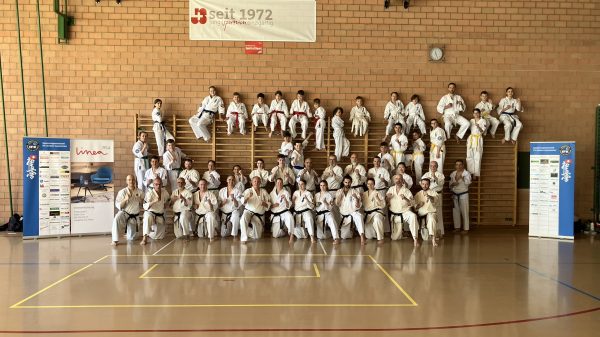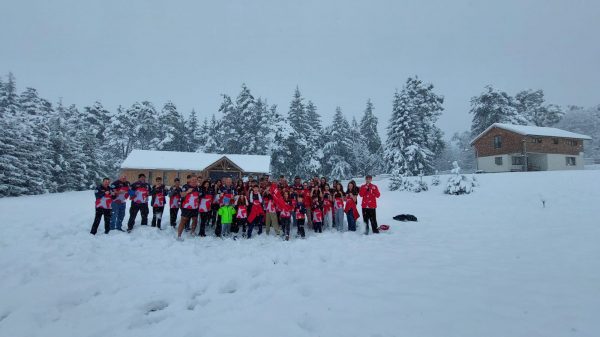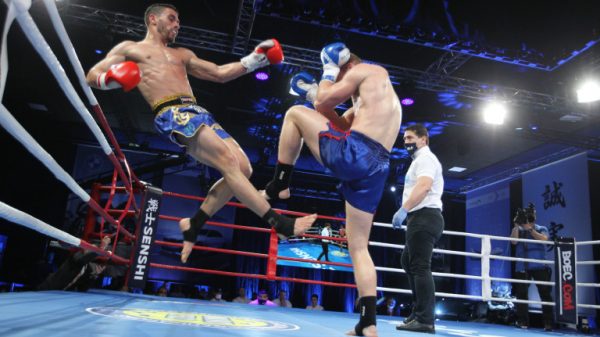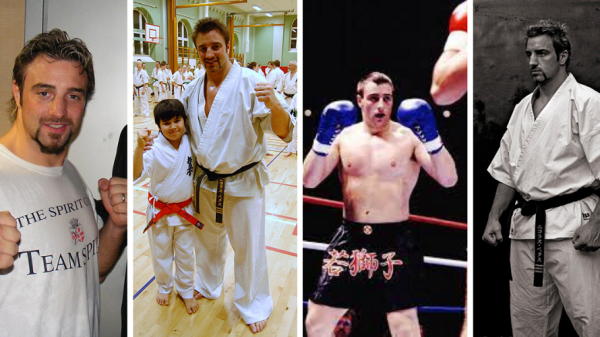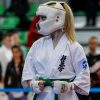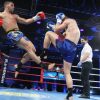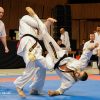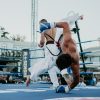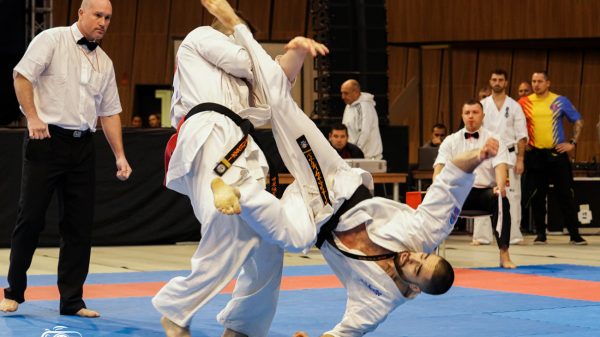By Graham Noble (2007)
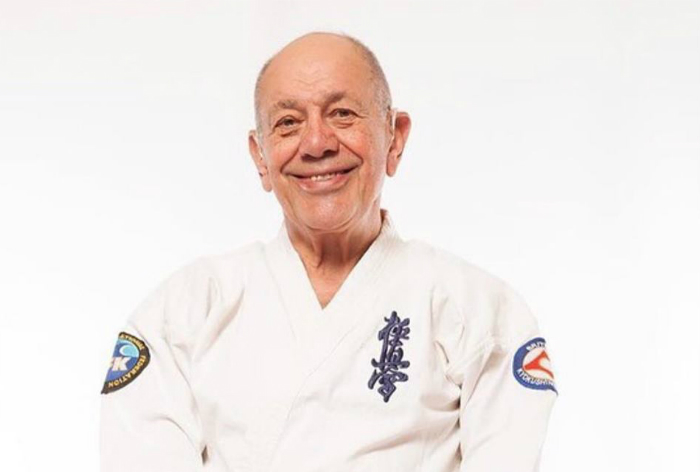
Very few men deserve the accolade living legend but in Karate circles few will disagree that Hanshi Steve Arneil has rightly
earned such a reputation. He was the first man inducted into the ‘Combat’ Hall of Fame, and the first man to complete the infamous 100 Man Kumite under the tutelage of the legendary Mas Oyama. This interview was conducted on the eve of the twenty-first (1996) British Kyokushinkai Championships at Crystal Palace, London.
I had wanted to meet Steve Arneil for many years because he is, and has been, a very important figure both in British, and Kyokushinkai karate history. As well as being the leading figure in British Kyokushinkai since 1965, he was the coach of the British Karate Team in a golden era, which saw it win the World Championship and become a major force in tournament karate.
His life has been “a life in Kyokushin”. He started training at the famous “Oyama Dojo” when the style itself was only a few years old, lived through its development into real power in the karate world, and saw at first hand the problems which later set in. These problems led eventually to his break with the honbu (headquarters), but his emotional links with Mas Oyama and his roots in Kyokushinkai continue to run deep. After the interview, when we talked about the passing of Mas Oyama, and the circumstances which followed, he was close to tears several times.
KYOKUSHINKAI IN ENGLAND
OK, so you came to England in 1965?
STEVE ARNEIL: Yes, in 1965, at Mas. Oyama’s request, as I said earlier. I met up with Bob Boulton, and we opened up the first dojo
at the London Judo Society, which became the London Karate-kai.
That was in the early days of karate in Great Britain.
STEVE ARNEIL: That’s right, it was very early. That was the time Suzuki and Enoeda had just arrived. Those years were just spent building up the organization.
Was it hard?
STEVE ARNEIL: It was hard, but in a way, it was good too, because the training I was doing was fantastic. People liked it, but if I did
that same training today, I’d have no-one in the dojo.
Has karate changed a lot since then?
STEVE ARNEIL: Oh yes, things have changed. But…many people ask me how would my students of those years do now. And I have to be honest and say I think they’d get slaughtered, because of the new techniques and training methods that have come in. Where they would win, though, would be in pure determination, spirit. But the technical ability has improved so much with different training methods, new ways of doing things. I myself was always keen to learn as much as I could from everybody else, and adapt it if I felt it would work for us. And this is the way Kyokushin in Britain developed, but never, ever did I break away from the traditions: the basics, the kata, and the strict discipline of fighting. If you fought somebody and you didn’t have the decency to shake his hand afterward, then don’t bloody well fight. And this is the way I still look at my people. And this is why at our championships if I hear one boo, I am on the mike immediately to the crowd. It is the worst discourtesy to show to two fighters. If a fighter has made an infringement, then the referees are there to handle it, not people standing up in the crowd and booing.
In those days, the 1960’s and early 1970’s British karate seemed to be more together, you had national championships in which all the major styles took part.
STEVE ARNEIL: Yes, the good old BKCC (British Karate Control Commission) Championships.
Some of your students fought in them, Brian Fitkin for example.
STEVE ARNEIL: Ah, Brian Fitkin, yes. Brian Fitkin was a brilliant Kyokushinkai man. A good student, and even to this day, I still think very fondly of Brian. But at that time we weren’t doing what we are doing now ~ knock-down fighting, or let’s call it the Kyokushinkai way of fighting. We were doing ~ and this was very difficult for me ~ point fighting or you could say WUKO (World Union of Karate Organisations) type fighting. I wasn’t too happy with the idea, but I knew that if I was to survive in this country and promote Kyokushin, I would have to fall into line. I was taught by my teacher to be adaptable, which I was. So I continued to train the way we’d always trained, but I added also the WUKO form of fighting and we became very successful at it. I was very, very honored when I was approached and asked if I would become the manager of the British karate team. I thought that was fantastic and I said yes, I would like to be because I also thought it would be a very good opportunity to also get Kyokushinkai known because I’m a Kyokushinkai man. And it happened at that time that I had in the team ~ not because they were from my organization, good Kyokushinkai men like Brian Fitkin, Ticky Donovan ~ because he was Kyokushinkai then ~ Howard Collins, and various other boys who showed tremendous effort as Kyokushinkai students. Brian, I would have to say, was the best as far as our WUKO representatives were concerned. He fought once knockdown in Japan, but not thereafter, he concentrated mainly on WUKO. And to me he was the prize, he was like a stalking tiger, he was brilliant. If he had put his heart into a knockdown, he would have
been the same in that.
Howard Collins fought knockdown in Japan, didn’t he?
STEVE ARNEIL: Oh, Howard Collins was brilliant as a Kyokushinkai fighter, he did very well, a tremendous fighter.
The British karate squad was very strong at that time.
STEVE ARNEIL: After a lot of hard work, and by having an open mind, we built up a very powerful squad from all styles, and that was a tremendous experience for me as they also helped me improve my knowledge in all styles.
You had some good fighters.
STEVE ARNEIL: I’ll put my head on the block. I would say, my team, the team that won the World Championships, if I could get them today, at the same age, the same level, they would beat the teams now. They were brilliant ~ Bob Poynton, Terry O’Neill, Stan Knighton, Ticky Donovan, Hamish Adams, Billy Higgins, Brian Fitkin, I’m sorry if I’ve forgotten some names, but they were great, and they came from all styles. I managed to get them into believing we were one team. It didn’t matter what style they came from, we were a British team, and I bred that into them all the time. And, of course, we beat the Japanese in Paris [1972], which they weren’t too happy about, and I told Kanazawa at the time ~ because he was their manager ~ “When we meet you again, we’ll become the World Champions”. He said, “Never!”, and I replied, “You watch us!” And then in Long Beach, we pulled it off, and I was very happy that I could give my services to my country in this way, and help the fighters for the future. It’s turned out excellently too. So far Ticky (Ticky Donovan, Steve Arneil’s successor as British coach) has done a tremendous job and we are still up there, and I hope Vic Charles, who is taking over from Ticky, will continue the tradition of producing strong British teams because I think at the moment Britain has the highest level of martial art in Europe. I’m talking of the general level. Of course, we have cowboys like everyone else, but if you take the serious practitioners, I think we are a very strong martial
arts country.
THE KYOKUSHINKAI TOURNAMENTS
Around 1969, the Kyokushinkai in Japan held its first National Championships under knockdown rules.
STEVE ARNEIL: Yes, and soon after that we had our own tournament in this country. In 1975 there was the first World Tournament, and those years were just brilliant. Can we talk about some of the fighters form that period, like Katsuko Sato, the first World Champion?
STEVE ARNEIL: Big Sato! Very strong, very dedicated, definitely a world champion.
Royama?
STEVE ARNEIL: Oh Royama. Royama and I grew up in the dojo, he was my kohai. So were people like Soeno who’s now head of Shidokan karate. So I was giving them a hard time. But these were all good fighters and gentlemen, and when I say gentlemen, I mean that on a high level. Soeno was one of the best gentlemen I’ve ever met. Even to this day, I have tremendous respect for him, his character, the way he does things. But people like Azuma, Sato, Sampei, Ninomiya, they were all tremendous fighters. I don’t think there was any fighter who didn’t deserve the honors he won. Because at that time they were the kingpins; the world around them was still learning the game. And then slowly but surely Europe got stronger and stronger and the threat [to the Japanese] was there. Then the rest of the world developed and it became quite difficult for the Japanese to dominate like before, and the tournaments were no longer one-sided affairs.
There was a lot of dissent from the foreign countries about the way some of these tournaments were run, especially the 1991 tournament.
STEVE ARNEIL: This is one of the reasons I got into hot water because for one thing I didn’t like the way the draw was done. Then I didn’t like the way the Japanese could overturn decisions so they went in their favor. I didn’t like the conniving that went on. There were times definitely when the non-Japanese fighters were done in. They could have become World Champions.
What was wrong with the draw?
STEVE ARNEIL: Well, how can you do the draw six months ahead then put in a bye for someone? And when the day of the fighting comes the whole thing is changed. I objected to it and I always made it clear I objected. OK, we fought open weight, so you had to take what came your way. But it was so neatly arranged that the Japanese ~ and this is no disrespect to the Japanese fighters themselves, they were very good ~ the Japanese were given an edge because they fought smaller opponents while our fighters were getting hammered by the big opponents.
By the time any of our men got through, they were so beaten up, they would lose. It was also said that the strongest Western fighters were matched against each other in the early rounds.
STEVE ARNEIL: Of course, It was obvious. I don’t have to tell you that, just look at the tapes. And all this, of course, made me sad, because I never expected this to happen in Kyokushinkai. But then again, politics, sponsorships, all those kinds of things were Japanese. I got into a lot of hot water because I was told personally to change a decision and I refused point-blank. And I made it clear to my teacher, who I loved very much, that I would grab the mike and I would tell the whole audience what was happening and then I would walk out. And he said, “I know you will do it, so we won’t change the decision”. And he smiled at me, and afterward, he said: “You still haven’t changed”. He respected me for that. But I can understand his point because he was under pressure too from many things I don’t know about. But I would never be persuaded to change a decision, and I did object strongly. And so did Nakamura, and so did Shigeru Oyama. It seemed like we were just
going there as puppets, for their entertainment. We didn’t have a hope in hell of winning. I always said, why don’t you do the draw a week before the tournament and do it as it should be done as we do it here? Our draw hasn’t been done yet; it’ll be done tonight, the evening before the tournament. But to do it six months before they gave us all kinds of excuses, but it was just a con. So the Western fighter would fight against the Japanese, who would be good, but the Western fighter would be better. And then the Japanese would swing the decision on weight, but before they did that, they would look at all the aspects to the thing. So if the foreigner weighed more, they would go on weight. But if it was the other way round they would decide on boards broken, if the Japanese had broken more board. There was no consistency. They didn’t follow the system, which is weights, then boards, then decision. And I was against all this, I argued and protested about it until well, things happened. Certain people in my own group took advantage of it, and I got put in the hot seat. But even at that point, I would not change, because Mas Oyama himself taught me to be a man, to keep to my principles, and I know that even to his last day, he would respect me for that because he said to me obviously I can’t prove it, people will have to believe me or not ~ he said to me “If there’s anyone ever who will continue the true spirit of Kyokushin Kai, it will be you”. And this is my job; I will do it to the end, maybe not under the Japanese flag, but I will do it under my own flag.
LEAVING MAS OYAMA
You left the Kyokushinkai organization eventually. That must have been a very hard decision for you.
STEVE ARNEIL: Oh, it was a hard decision. You know it was my life. I understand Mr. Oyama had no option, he was under a lot of pressure. But there were a lot of false reasons given as to why I left. Supposedly I wanted to take over, I wanted to play God, all kinds of things were said against me. But that’s life. If you’re in the hot seat, you have to take what comes. But I dispute everything they say. My object was not to override Japan, my object was to give credibility to my teacher, which he wanted. I was always excited when we did well because I was thinking, “Sosai’s going to be very happy”. It was for him, I didn’t want to be the world controller or the world president. But some people didn’t like the rules I made and they took advantage of it and finally, the day came when the old man kensoku’d me. That meant I wasn’t put out of Kyokushinkai, but I had to stay in my own dojo. I couldn’t go out of my own dojo [to teach or train] and I thought that was ridiculous.
When I was Kensoku’d I wrote to my teacher, I said, “You know, we’ve been around so many years, I grew up in front of you” ~ because, indirectly, he was like my father “and you can’t tell your son to stay in his room when he’s thirty years old. I have done nothing at all to injure you or hurt you. All I’ve tried to do is give you credibility, and to compliment you on all the things you have done. I’ve done the best I can, and I cannot accept this”. And he replied saying I had to accept it but when I get someone who I taught from white belt phoning me up and telling me to stay in my dojo, that’s enough. Then the BKK (British Karate Kyokushinkai) made a decision, that if Japan wasn’t going to change then we weren’t going to change because we didn’t feel any necessity to. We also didn’t like the politics that were going on within our own committee, where members would sit on the committee and then report back to Japan without our knowledge. Then they said they wanted Branch chiefs, and we disagreed as an organization because we didn’t see the necessity for Branch chiefs. “Branch chiefs” I will say openly, is a gimmick for making money. You know, give me x amount of money and I’ll give you a certificate and you’re a Branch chief. But they broke the rules because at that time, to be a Branch chief you had to have 3,000 members- Some people who became Branch chiefs didn’t even have 5 members. I don’t like working that way, and the BKK had functioned, and Europe had functioned very well without Branch chiefs. It was country representatives, and they were responsible, with a committee, and the committee made the decisions. But looking back at it, I can understand why Branch chiefs were introduced. It’s the domino effect: if one doesn’t do it, the next one will. And this is really where Mr. Oyama and myself came to the end of the line. I knew he felt very sad about it, but he was in a position where he had made a decision, and if it looked as if he had gone back on that decision ~ which I knew he wanted to do very badly ~ he would have lost face.
To me “face” doesn’t mean anything, but that is the Japanese way. Then, finally, I went to Switzerland, where he was supposed to be going. I thought this would be our last consultation, but he didn’t turn up. I wanted to meet openly, in front of everybody, so no-one would be making up stories. And I feel I was treated badly, after all, I had done, because the mandate that the other groups had given me to take to Japan about the fighting and all that; they had all signed it, yet when it came for them to support me, they didn’t do it. I never ended up going to Japan. I resigned as European President, and I resigned from Kyokushinkai Honbu (head dojo). And that is when the IFK was created because I was inundated by people who had the same kind of thinking as I had, who had the same type of problems. They were all ex-Kyokushinkai. I thought this is crazy, to take this all on at my time of life. But then I thought, why not. Sosai said I must always follow the Kyokushinkai principles, and so I decided I’d do it.
How big is the IFK now?
STEVE ARNEIL: It’s big. We’ve got over twenty countries and we’ve only been in existence for four or five years. We’re doing our first
world tournament in Moscow nest year. It’s a healthy organization, but what will take place in the future, nobody knows. My ambition
is to create some happiness and the proper spirit of budo.
There are now a lot of Kyokushin or Kyokushin-offshoot groups in the world, like Shigeru Oyama’s, Nakamura’s and so on.
STEVE ARNEIL: Yes, but often they have done what I haven’t done. When people ask me what style I do, I say “Kyokushin”. I haven’t changed the style. Shigeru Oyama has the World Oyama style, and he has changed it in line with his ideas. Tadashi Nakamura has his Seido style, and he has changed certain things, although obviously there’s a lot of Kyokushin in it. Soeno of Shidokan, he has changed some things. I haven’t. I keep Kyokushin techniques and I am a Kyokushin man. The old man made me a Kyokushin man. I took it very seriously when he said I would be a Kyokushinkai man all my life. What I do know, is that if Sosai were alive today he would be a very, very sad man. He didn’t want it to be like this. He wanted a healthy family. He wanted something with credibility. He wanted people to say, “Hey, they’re кyokushinkai, they’re a strong group.” It was never his intention that things would turn out the way they did, but in a way, he should take some of the blame. He didn’t listen to people who loved him very much. I want to keep that spirit of Kyokushin. To me it was beautiful. I was a wild boy when I was young, and I don’t know where I’d have been without Kyokushin. So I want to give something back. But no way will I be untrue to my principles otherwise, what was it all for? And I want to say, if it wasn’t for my good students and a lot of good people around me, I couldn’t have accomplished it. So I thank all my students, all my executives, and all my coaches for what we’ve achieved.


